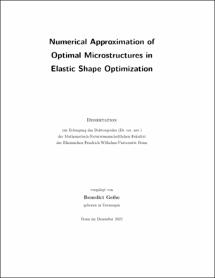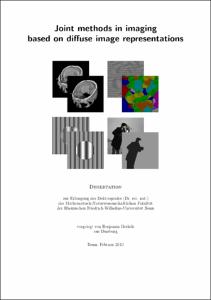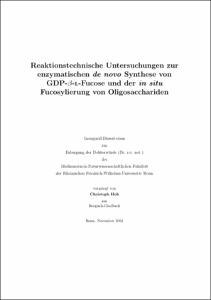Geihe, Benedict: Numerical Approximation of Optimal Microstructures in Elastic Shape Optimization. - Bonn, 2023. - Dissertation, Rheinische Friedrich-Wilhelms-Universität Bonn.
Online-Ausgabe in bonndoc: https://nbn-resolving.org/urn:nbn:de:hbz:5-70818
Online-Ausgabe in bonndoc: https://nbn-resolving.org/urn:nbn:de:hbz:5-70818
@phdthesis{handle:20.500.11811/10890,
urn: https://nbn-resolving.org/urn:nbn:de:hbz:5-70818,
author = {{Benedict Geihe}},
title = {Numerical Approximation of Optimal Microstructures in Elastic Shape Optimization},
school = {Rheinische Friedrich-Wilhelms-Universität Bonn},
year = 2023,
month = jun,
note = {We develop and analyze a numerical two-scale optimization scheme for structural shape optimization. Whenever cost functionals, such as the elastic energy, are subject to minimization, while meeting a constraint on the available material, the emergence of microstructures can be observed. The costs are constantly reduced by fine-scale structures on a decreasing length scale δ. For an optimum, a generalized notion is required in the limiting case δ → 0, where materials are macroscopically characterized by an effective density θ ∈ [0, 1] and an effective behavior only. These are governed by the concrete realization of the underlying microstructure and there are provable optimal, yet nonunique, constructions. Being mostly of theoretical interest, they lack a physical counterpart, which could serve as guidance for manufacturing real materials. The goal of this work is to establish a flexible algorithmic method, that can assess the approximation quality of alternative, simple microstructure models.
A numerical simulation and optimization can only be computationally feasible when distinct length scales are treated in a coupled but separated manner. This work builds upon the intuitive idea of pointwise probing the reaction of the underlying microstructure. A linearization of the macroscopic displacement serves as an affine-periodic boundary condition for a locally attached cell problem, whose solution is used as the microscopic correction. The intuitive approach is rigorously derived and linked to well-known concepts of homogenization, two-scale convergence and the heterogeneous multiscale method (HMM). This allows to adopt results on the approximation quality of the two-scale approach and its discretization.
The deformation of the elastic bodies is modeled via the partial differential equations of linearized elasticity. Within the microscopic cells, the shapes of perforations, parametrized by few degrees of freedom, will be subject to optimization. For this purpose, the shape derivative will be computed analytically in the two-scale context via an adjoint approach. Upon discretization, a finite dimensional optimization problem with constraints on the microscopic geometries and the globally available amount of material is achieved. The numerical scheme uses a finite element discretization on the macroscale and a boundary element method on the microscale. For the optimization problem, an SQP-algorithm of the software Ipopt is employed.
At first we consider synthetic problems that allow to study the behavior of optimized microstructures and identify their limits with respect to optimality. On the basis of classical shape optimization problems, we then compare various microstructures among each other and study the gap towards optimality, realized by the analytically optimal sequential lamination model. Furthermore we discuss the influence of numerical parameters and algorithmic speed-up measures.
Next the two-scale scheme is applied to problems in risk averse stochastic optimization, where multiple loads with different probabilities of occurrence need to be taken into account in an appropriate manner. In view of the appearing highly nonlinear functionals, the scheme proves to be robust. Furthermore the concept of stochastic dominance is introduced, which allows to compare results with single-scale optimized shapes.
Finally we derive a posteriori error estimates for the two-scale scheme, following the dual weighted residual (DWR) approach. They are employed to adaptively refine the macroscopic computational grid, which allows to achieve results comparable to uniform refinement with drastically reduced computational cost. The adaptive scheme is used both with the analytical sequential lamination model and the numerical two-scale approach. Furthermore an error estimator is developed, which allows to locally assess the modeling error of the simple microstructures with respect to optimal materials.},
url = {https://hdl.handle.net/20.500.11811/10890}
}
urn: https://nbn-resolving.org/urn:nbn:de:hbz:5-70818,
author = {{Benedict Geihe}},
title = {Numerical Approximation of Optimal Microstructures in Elastic Shape Optimization},
school = {Rheinische Friedrich-Wilhelms-Universität Bonn},
year = 2023,
month = jun,
note = {We develop and analyze a numerical two-scale optimization scheme for structural shape optimization. Whenever cost functionals, such as the elastic energy, are subject to minimization, while meeting a constraint on the available material, the emergence of microstructures can be observed. The costs are constantly reduced by fine-scale structures on a decreasing length scale δ. For an optimum, a generalized notion is required in the limiting case δ → 0, where materials are macroscopically characterized by an effective density θ ∈ [0, 1] and an effective behavior only. These are governed by the concrete realization of the underlying microstructure and there are provable optimal, yet nonunique, constructions. Being mostly of theoretical interest, they lack a physical counterpart, which could serve as guidance for manufacturing real materials. The goal of this work is to establish a flexible algorithmic method, that can assess the approximation quality of alternative, simple microstructure models.
A numerical simulation and optimization can only be computationally feasible when distinct length scales are treated in a coupled but separated manner. This work builds upon the intuitive idea of pointwise probing the reaction of the underlying microstructure. A linearization of the macroscopic displacement serves as an affine-periodic boundary condition for a locally attached cell problem, whose solution is used as the microscopic correction. The intuitive approach is rigorously derived and linked to well-known concepts of homogenization, two-scale convergence and the heterogeneous multiscale method (HMM). This allows to adopt results on the approximation quality of the two-scale approach and its discretization.
The deformation of the elastic bodies is modeled via the partial differential equations of linearized elasticity. Within the microscopic cells, the shapes of perforations, parametrized by few degrees of freedom, will be subject to optimization. For this purpose, the shape derivative will be computed analytically in the two-scale context via an adjoint approach. Upon discretization, a finite dimensional optimization problem with constraints on the microscopic geometries and the globally available amount of material is achieved. The numerical scheme uses a finite element discretization on the macroscale and a boundary element method on the microscale. For the optimization problem, an SQP-algorithm of the software Ipopt is employed.
At first we consider synthetic problems that allow to study the behavior of optimized microstructures and identify their limits with respect to optimality. On the basis of classical shape optimization problems, we then compare various microstructures among each other and study the gap towards optimality, realized by the analytically optimal sequential lamination model. Furthermore we discuss the influence of numerical parameters and algorithmic speed-up measures.
Next the two-scale scheme is applied to problems in risk averse stochastic optimization, where multiple loads with different probabilities of occurrence need to be taken into account in an appropriate manner. In view of the appearing highly nonlinear functionals, the scheme proves to be robust. Furthermore the concept of stochastic dominance is introduced, which allows to compare results with single-scale optimized shapes.
Finally we derive a posteriori error estimates for the two-scale scheme, following the dual weighted residual (DWR) approach. They are employed to adaptively refine the macroscopic computational grid, which allows to achieve results comparable to uniform refinement with drastically reduced computational cost. The adaptive scheme is used both with the analytical sequential lamination model and the numerical two-scale approach. Furthermore an error estimator is developed, which allows to locally assess the modeling error of the simple microstructures with respect to optimal materials.},
url = {https://hdl.handle.net/20.500.11811/10890}
}









